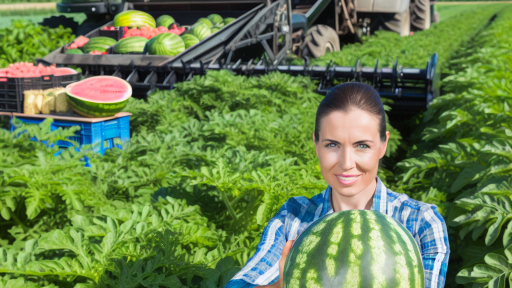Understanding Customer Needs and Preferences in Farm Sales
Identifying Customer Demographics
Understanding customer demographics is critical for farm sales.
First, identify the age groups of your customers.
Next, consider their income levels and occupation.
Additionally, analyze their geographic distribution.
Understanding these factors will guide your marketing strategies.
Gathering Customer Feedback
Customer feedback serves as a valuable resource.
Utilize surveys to collect information on preferences.
Encourage testimonials to gain deeper insights.
Social media interactions can provide real-time feedback.
Moreover, consider hosting focus groups for detailed discussions.
Analyzing Purchase Behavior
Purchase behavior reveals essential patterns and trends.
Track which products customers buy most frequently.
Additionally, analyze the time of year when purchases peak.
Understanding these patterns assists in effective inventory management.
Moreover, it helps tailor promotions based on customer habits.
Transform Your Agribusiness
Unlock your farm's potential with expert advice tailored to your needs. Get actionable steps that drive real results.
Get StartedAdapting to Seasonal Changes
Seasonality significantly influences customer preferences.
Recognize the seasonal products that attract customers.
For instance, spring usually sees a rise in plant sales.
Summer may bring a shift towards fresh produce.
Thus, adjust your offerings according to these seasonal demands.
Utilizing Technology for Enhanced Experience
Technology can enhance customer experience in farm sales.
Implement a user-friendly website for online shopping.
Use mobile apps to keep customers informed of promotions.
Additionally, consider utilizing customer relationship management systems.
This technology helps tailor communications effectively.
Creating a Personalized Shopping Experience for Farm Products
Understanding Customer Needs
Every customer has unique preferences and needs.
Identifying these needs is the first step to personalizing their experience.
Surveys and feedback forms can provide invaluable insights.
Data analysis can reveal purchasing trends and habits.
Customizing Product Recommendations
Utilizing the collected data can enhance product recommendations.
Personalized suggestions can lead to increased sales and customer satisfaction.
For instance, if a customer frequently buys organic vegetables, suggest related items.
This approach can create a tailored shopping experience.
Creating a User-Friendly Online Platform
A seamless online shopping experience is essential.
Ensure your website is easy to navigate and visually appealing.
Offer clear categories and filters for customers to find products quickly.
Additionally, optimize the mobile experience.
Implementing Loyalty Programs
Loyalty programs can effectively engage customers.
Provide rewards for repeat purchases to incentivize loyalty.
Showcase Your Farming Business
Publish your professional farming services profile on our blog for a one-time fee of $200 and reach a dedicated audience of farmers and agribusiness owners.
Publish Your ProfileConsider offering exclusive deals or discounts to loyalty members.
This can foster a deeper relationship with your customers.
Hosting Community Events
Community events can enhance customer connection.
Host workshops, farm tours, or farm-to-table dinners.
Engaging customers in person builds a sense of belonging.
Additionally, it showcases your farm products in a unique setting.
Utilizing Social Media for Engagement
Social media can serve as a powerful tool for interaction.
Share engaging content about your products and farm practices.
Encourage customers to share their experiences online.
Building an online community encourages recurring visits.
Pursuing Continuous Improvement
The customer experience should evolve over time.
Regularly assess customer feedback to identify challenges.
Incorporate new ideas and technologies as they emerge.
This commitment to improvement will help retain customers.
Utilizing Technology to Enhance Customer Engagement
Embracing Digital Platforms
Digital platforms play a vital role in connecting farm sales with customers.
These platforms empower farmers to showcase their products effectively.
Moreover, they enable real-time communication between farmers and customers.
For instance, social media promotes farm products to a broader audience.
Additionally, websites serve as virtual storefronts for farmers.
Implementing E-Commerce Solutions
Implementing e-commerce solutions can significantly enhance customer convenience.
These solutions provide easy access to farm products online.
Customers can place orders directly through user-friendly interfaces.
This streamlines the purchasing process for everyone involved.
Furthermore, online payments simplify transactions and build trust.
Leveraging Mobile Applications
Mobile applications are revolutionizing customer engagement strategies.
These apps offer personalized experiences tailored to individual preferences.
Customers can receive notifications about new products and promotions.
This immediacy keeps customers informed and engaged.
Additionally, apps allow for easy customer feedback collection.
Using Data Analytics for Customer Insights
Data analytics provides valuable insights into customer behavior.
Farm sales can utilize this data to make informed decisions.
Understanding customer preferences enables targeted marketing strategies.
Furthermore, analytics help identify trends and emerging markets.
This proactive approach enhances overall customer satisfaction.
Enhancing Customer Service with Chatbots
Chatbots offer immediate assistance to customers seeking information.
These AI-driven tools can answer frequently asked questions promptly.
Moreover, chatbots are available 24/7 to support customer inquiries.
This constant availability improves overall customer experience.
Additionally, chatbots can assist in guiding customers through the purchasing process.
You Might Also Like: Community Supported Agriculture for Small Farmers
Showcase Your Farming Business
Publish your professional farming services profile on our blog for a one-time fee of $200 and reach a dedicated audience of farmers and agribusiness owners.
Publish Your ProfileDeveloping Efficient Communication Channels with Customers
Importance of Open Communication
Open communication fosters trust between farmers and customers.
Trust enhances customer loyalty and encourages repeat business.
Reliable communication channels prevent misunderstandings.
Furthermore, they keep customers informed about products and services.
Utilizing Technology for Better Connections
Technology offers various tools for effective communication.
One popular approach is using social media platforms.
Farmers can engage directly with customers through these channels.
Additionally, email newsletters provide valuable updates.
These updates may include seasonal promotions and product availability.
Creating a Feedback Loop
Establishing a feedback loop is crucial for improvement.
Farmers should actively seek customer opinions on products.
Surveys and polls can gather essential insights.
Moreover, addressing feedback shows customers their voices matter.
This engagement enhances customer satisfaction and loyalty.
Training Staff for Effective Communication
Staff training is essential to ensure effective customer interactions.
Employees should understand the importance of clear communication.
They can also learn to handle customer inquiries and issues professionally.
Furthermore, knowledgeable staff can provide valuable product information.
Building Personal Relationships
Personalized interactions can significantly enhance customer experience.
Farmers should strive to connect personally with customers.
Remembering customer preferences builds stronger relationships.
These connections encourage customers to return for future purchases.
Delve into the Subject: Sustainable Livestock Management Tips
Implementing Loyalty Programs and Incentives for Repeat Customers
The Importance of Loyalty Programs
Loyalty programs create a bond between customers and your farm.
They encourage repeat purchases while enhancing customer satisfaction.
Moreover, these programs help you gather valuable customer data.
This information allows for personalized marketing strategies.
Types of Loyalty Programs
Consider various types of loyalty programs for your farm sales.
A points-based system rewards customers for each purchase.
Discount programs provide immediate benefits, increasing sales momentum.
Referral programs incentivize customers to introduce new clientele.
Finally, tiered programs encourage increased spending for better rewards.
Incentives to Boost Engagement
Provide exclusive offers to reward returning customers.
For instance, special discounts on seasonal products attract repeat buyers.
Offering free samples can entice customers to try new items.
Additionally, hosting members-only events can build community ties.
Communication is Key
Inform customers about your loyalty programs through various channels.
Social media posts generate buzz about upcoming rewards.
Email newsletters keep customers informed about their points status.
In-store signage reinforces the value of signing up for programs.
Showcase Your Farming Business
Publish your professional farming services profile on our blog for a one-time fee of $200 and reach a dedicated audience of farmers and agribusiness owners.
Publish Your ProfileMeasuring Success
Track the effectiveness of your loyalty programs regularly.
Use metrics like repeat purchase rates and customer retention to evaluate success.
Adjust your offerings based on customer feedback for continuous improvement.
Emphasizing the right metrics ensures sustained customer engagement.
Learn More: Soil Health Management for Small-Scale Farmers

Gathering and Analyzing Customer Feedback for Continuous Improvement
The Importance of Customer Feedback
Customer feedback plays a crucial role in farm sales.
It provides insights into customer preferences and expectations.
Moreover, feedback helps identify areas for improvement.
Methods for Collecting Feedback
Farmers can employ various methods to gather feedback.
Surveys are effective tools for obtaining valuable information.
Additionally, feedback forms can be placed at sales points.
Social media platforms offer a way to engage customers directly.
Furthermore, face-to-face interactions allow for deeper insights.
Analyzing Customer Feedback
Once collected, feedback should be analyzed systematically.
Data analysis tools can identify trends and patterns.
Qualitative feedback benefits from thematic analysis.
Quantitative data, on the other hand, can be statistically analyzed.
Implementing Changes Based on Feedback
Farmers should take actionable steps based on insights gathered.
Changes can enhance product quality and customer service.
Regularly reviewing the implemented changes fosters continuous improvement.
By acting on feedback, farmers build stronger customer relationships.
Monitoring Progress
Continuous improvement requires ongoing monitoring of changes.
Farmers can track sales metrics as indicators of success.
Customer satisfaction surveys can gauge the effectiveness of changes.
Regular check-ins with customers maintain engagement and trust.
You Might Also Like: Promoting Ethical Farming In Communities
Training Staff to Provide Outstanding Customer Service in Agricultural Settings
Importance of Customer Service Training
Customer service training enhances the overall experience for farm visitors.
It equips staff with the skills to engage and assist customers effectively.
Quality training leads to increased customer satisfaction and loyalty.
Creating a Customer-Centric Culture
Establishing a customer-centric culture benefits all stakeholders.
Encourage staff to prioritize customer needs and feedback.
This shift promotes caring and personalized service throughout the farm.
Identifying Training Needs
Assess current staff skills to highlight training gaps.
Consider customer feedback to identify areas for improvement.
Use assessments to tailor training programs effectively.
Developing Training Programs
Design engaging training programs focusing on essential skills.
Include role-playing scenarios to simulate real customer interactions.
Incorporate product knowledge to enhance staff confidence.
Utilize both online and in-person training methods for flexibility.
Measuring Training Success
Implement metrics to evaluate the effectiveness of customer service training.
Showcase Your Farming Business
Publish your professional farming services profile on our blog for a one-time fee of $200 and reach a dedicated audience of farmers and agribusiness owners.
Publish Your ProfileRegularly collect customer feedback to gauge satisfaction levels.
Monitor staff performance through customer interactions.
Use results to refine future training initiatives continuously.
Encouraging Continuous Improvement
Foster an environment that values ongoing learning and development.
Encourage staff to share experiences and learn from one another.
Regularly update training materials to reflect new practices and products.
This approach keeps staff knowledgeable and engaged.
Showcasing Transparency and Sustainability in Farm Practices to Build Trust
Commitment to Transparency
Farmers today must prioritize transparency in their operations.
This commitment builds trust among consumers.
Sharing information about farming practices is essential.
Many consumers seek to understand where their food comes from.
Open communication channels encourage consumer engagement.
For example, farms can utilize social media effectively.
Sharing stories about daily operations creates authenticity.
Implementing Sustainable Practices
Sustainability has become a significant concern for consumers.
Adopting sustainable farming techniques benefits the environment.
Farmers can practice crop rotation to enhance soil health.
Using organic fertilizers reduces chemical runoff.
Water conservation methods improve resource management.
Moreover, sustainable practices often lead to cost savings.
Engaging with the Community
Building trust extends beyond farming practices.
Engaging with the local community fosters connection.
Farmers can host open days to showcase their operations.
This interaction allows consumers to ask questions directly.
Partnerships with local schools promote agricultural education.
By involving the community, farms create invested consumers.
Providing Certifications
Certifications demonstrate a farm’s commitment to quality.
Numerous programs exist for sustainable farming practices.
Obtaining these certifications provides a competitive edge.
They assure consumers of quality and sustainable methods.
Farmers should display certifications prominently on products.
This visibility reinforces accountability and trustworthiness.
Utilizing Technology for Transparency
Technology plays a pivotal role in increasing transparency.
Many farms implement traceability systems for their products.
These systems allow consumers to track food from farm to table.
Using apps can simplify sharing practices and farm updates.
Additionally, drones and sensors enhance farming efficiency.
By leveraging technology, farms can meet consumer expectations.
Additional Resources
The Farm-to-Table Movement — AGRITECTURE
Assessing the Barriers to Increasing Customer Participation and …
Showcase Your Farming Business
Publish your professional farming services profile on our blog for a one-time fee of $200 and reach a dedicated audience of farmers and agribusiness owners.
Publish Your Profile



